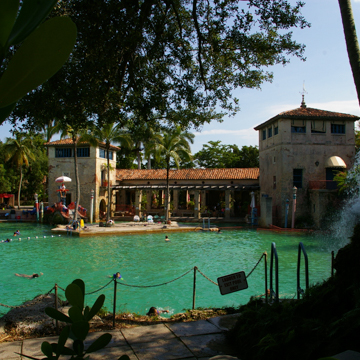The Venetian Pool exemplifies the atmosphere of leisure, opulence, and invented historical heritage envisioned for Coral Gables by the city’s founder, George Merrick, and brought to fruition by his talented design team of Phineas Paist and Denman Fink. Opened as the Venetian Casino in December 1924, the pool occupies the former oolitic limestone quarry that provided stone for many of the city’s early buildings, including the Merrick family residence, which gave its name, Coral Gables, to the new community.
The idea for Venetian Pool is sometimes credited to Edward “Doc” Dammers, who managed real estate sales for the Coral Gables Corporation, and was elected the city’s first mayor after its incorporation in April 1925. The abandoned quarry was a significant interruption in the urban fabric between several important planned landmarks, including De Soto Fountain and City Hall. The solution involved lining the quarry with concrete to create an 820,000-gallon pool filled with fresh water drawn daily from the underground aquifer via artesian wells. On the south side of the pool a picturesque ensemble of buildings house changing rooms and other facilities. Allusions to the canals and lagoon of Venice abound in the pool, including striped wood gondola poles around the perimeter and an arched bridge leading to a small island. Paist and Fink included a number of other fanciful elements with no Venetian provenance, including a waterfall and a grotto.
The buildings and landscape are detailed to appear decayed—almost decrepit—in order to produce an illusion of antiquity. Scenographic gestures like this were common in Coral Gables, where Merrick sought to imbue the new city with a sense of heritage by employing historical revivals in buildings and sites that seemed worn by age. Paist and Fink exaggerated this faux deterioration at the Venetian Pool, since the recreational program allowed for a more playful, even kitsch, attitude toward design. Hence, stucco surfaces are “worn away” to reveal brick or rough stone masonry “subsurfaces,” and the gondola poles are anchored slightly off plumb to look like they’ve settled in the mud of the Venetian lagoon.
Like other early civic structures in Coral Gables, the Venetian Pool helped establish the palette of construction materials, paint colors, and plantings required in the city. Its rough stucco surfaces are finished in warm earth tones carefully selected by Fink to convey a sense of Mediterranean character under the South Florida sunlight. The city’s sanctioned palette of coral rock, brick, barrel roof tile, wrought iron, and wood is employed in a combination of historical forms that include arcades, loggias, hipped roofs, and belvederes.
Paist honed his exuberant approach to design while working under Paul Chalfin at Villa Vizcaya in Miami, after studying architecture at the Drexel Institute in Philadelphia and the Ecole des Beaux Arts in Paris. His interest in a theatrical strain of neoclassicism and the production of civic identity through urban planning was excited by a visit to the 1893 World’s Columbian Exhibition in Chicago; the planning of Coral Gables offered Paist his first large-scale opportunity to employ City Beautiful planning techniques. He collaborated with Fink, a talented painter and graphic artist (and the brother of Merrick’s mother, Althea), who helped develop the picturesque Mediterranean Revival formal language of Coral Gables. Other key members of the Coral Gables design team included architect Walter DeGarmo and landscape architect Frank Button.
Designed as a place of carefree leisure, the Venetian Pool also provided a site for spectacular entertainment. The pool has been drained to provide seating for orchestras and big bands; when the pool hosted fashion shows, a wooden runway was installed across the water. Johnny Weismuller, Esther Williams, and other celebrities made public appearances that reinforced the sense of escapist fantasy.
To address concerns of sustainability and water conservation, the pool was retrofitted to recycle water back into the aquifer in 1989. It was subsequently renovated in 2009–2010 and in 2014–2015. The Venetian Pool remains a popular destination for locals and tourists.
References
Parks, Arva M. George Merrick's Coral Gables: Where Your 'castles in Spain' Are Made Real.Miami: Centennial Press, 2006.














